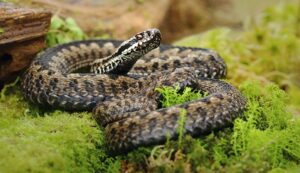Unveiling the Enigma: Understanding the Impact of Venomous Snake Bites
The Stealthy Threat of Snake Venom
Over 100,000 people die each year from snakebites, which may not seem like a big deal, but they are a serious global health problem that is often overlooked. This piece aims to bring attention to this silent threat by explaining the complexities of snake venom and stressing the importance of being more aware and acting quickly after being bitten by a snake.
Snakebites affect more than just the people who are bitten physically; they also affect a wider range of global health problems. Even though these bites have an alarmingly high death rate, they are often forgotten in favor of more well-known health risks. This oversight has made it harder for people to understand, which has slowed down reactions and, in many cases, led to deaths that could have been avoided.
If you look into the history of snake venom, you can see how it has changed over time. Venom has developed on its own more than a hundred times, showing how well it can adapt to different species. Snake venom is a complicated biochemical arsenal with many uses, from its main function in predation to its tactical application in self-defense. Understanding these genetic roots is essential for understanding the complexities of snakebites and developing effective ways to keep people from getting them.
Research into snake venom shows that it can be used for many things besides hunts and defense. During the breeding season, male platypuses use their poisonous spurs to compete, and tawny crazy ants use venom as a cure. This shows how versatile and complicated these biochemical cocktails are.
As we learn more about how snake venom has changed over time, it becomes clearer how important it is to act quickly. This article will explain the specific mechanisms and effects of different snake venoms. The article will also stress the importance of quickly administering antivenom to prevent possible fatal effects. During this very important time window, lives can be saved and long-term damage can be lessened.
The Intricate Purpose of Snake Venom
Venom is an amazing development that has been seen in many different species, each fine-tuned to serve a different, more complex purpose. Knowing venomous snakes better shows how this biochemical cocktail, which results from nature’s never-ending innovation, is a wonder of evolution.
About 700 front-fanged venomous snakes use their poison to defend themselves and hunt prey. This is one of the most important parts of their survival tactics. These snake-like predators, mostly from the Viperidae and Elapidae families, have developed venom as a powerful way to catch their food quickly. The complex venom these snakes have been perfecting for thousands of years lets them quickly disable or kill their prey, making the hunt successful and providing them with food and energy.
In addition to protecting them from being eaten, venom is a strong defense for these snakes. When faced with possible predators or risks, venom is a strong deterrent that sends a clear message to would-be attackers. This protective use of venom shows how adaptable it is, giving snakes a strong way to protect themselves from dangerous situations and get around in their environments.
In the Colubridae family, an extra 1,800 species with back wings have venom, though it is not as strong as the front-fanged species. Snakes’ venoms usually don’t pose much of a threat to people, but there are some exceptions. This shows how different snakes use different strategies in different ecological niches.
The changing connection between predators and prey in nature can be seen in how venom has evolved and become an important part of survival. That these creatures are so flexible, perfecting their biological weapons to fit the needs of their surroundings, says a lot. As we determine what venom is for, we learn more about how snakes act and the larger evolutionary forces that shape the world’s species.

The Varied Arsenal: What Venom Does
We can see how complex nature’s biology is by looking at how different venoms are. Venoms don’t all have the same effects; instead, they have a wide range of effects that are tailored to the needs and tactics of the snakes that use them.
 Included in the dangerous subgroup of vipers are adders and rattlesnakes. Their venoms are known for being hemotoxic. These venoms go after the circulatory system and set off a chain of events that can cause bleeding or make it harder for the blood to heal. Because it affects the blood system, the victim’s body reacts more complicatedly, which could have serious effects if not treated immediately. Understanding how hemotoxic viper venoms are is essential for creating successful treatment plans for people whom these animals have bitten.
Included in the dangerous subgroup of vipers are adders and rattlesnakes. Their venoms are known for being hemotoxic. These venoms go after the circulatory system and set off a chain of events that can cause bleeding or make it harder for the blood to heal. Because it affects the blood system, the victim’s body reacts more complicatedly, which could have serious effects if not treated immediately. Understanding how hemotoxic viper venoms are is essential for creating successful treatment plans for people whom these animals have bitten.
On the other hand, the elapids, which include cobras and mambas, show a different side of venom complexity. Their venoms are mostly neurotoxic, which means they mess up nerve signals and make their prey unable to move. This neurotoxicity shows that elapids are smart animals that try to subdue their food while reducing the chance of counterattacks quickly. Neurotoxic venom does more than make you unable to move. It often makes you lose consciousness quickly, which helps snakes do their job as predators.
There are two types of venoms: those that kill blood cells and those that hurt nerve cells. This shows how vipers and elapids have evolved to fit into different biological niches. It also shows how important it is to match medical treatments to each venom type’s unique effects, underlining the need for a complete understanding of how snakebites happen. As we learn more about the complicated effects of venom, we gain a deeper understanding of the unique ways these interesting animals have evolved to stay alive.
Beyond Convention: Uncommon Venom Applications
The story of venom goes beyond its usual roles in defense and hunting, telling an amazing story of how animals can use it in so many different ways. Venom has a bad image for being a dangerous weapon, but it turns out to be a biochemical cocktail with many different uses.
When it comes to strange changes, male platypuses are the best known. The poisonous spurs on the back legs of these one-of-a-kind monotremes are not used for hunting or defense but for fierce competition during the breeding season. Male platypuses fight very hard and use their poisonous spurs to show who is in charge and get the right to mate. This unusual use of venom as a weapon in competition adds another level of complexity to how these interesting animals reproduce.
Tawny crazy ants show an unexpected connection to venom when we look at insects. The venom of these tough ants is not used as a tool but as a defense against the venom of their most dangerous enemy, the fire ant. To counteract the harmful effects of fire ant venom, tawny crazy ants use their own poison, which is kind of like chemical warfare. This shows how smart and clever they are in how they interact with their environment.
Some species, like shrews, also use venom as a survival tool. These small animals are believed to use their venom to preserve food in an unusual way. The antimicrobial properties of shrew venom may help keep caught prey from breaking down due to bacteria so that it can be used later as a relatively fresh food source. This one-of-a-kind use of venom for food storage adds another interesting layer to the complexity of these small predators.
Why Some Snakes Are Deadlier
Because poisonous snakes are organized complicatedly, not all bites are the same. Some species have venoms that are so strong that they are completely deadly. The black mamba and the inland taipan are two snakes that show this phenomenon very clearly. The power of their venoms shows how predators and prey have evolved to avoid getting hurt.
 The black mamba (Dendroaspis polylepis), which is indigenous to sub-Saharan Africa, is regularly ranked among the snakes with the most venom in the world. Its venom is a complicated mix of neurotoxins, cardiotoxins, and other enzymes that work together to hurt its prey quickly and severely. The notoriety of the black mamba is a result of its venom’s strength and speed and accuracy in delivering multiple bites. This deadly mix makes the black mamba a dangerous predator that ensures its food is quickly and permanently hurt.
The black mamba (Dendroaspis polylepis), which is indigenous to sub-Saharan Africa, is regularly ranked among the snakes with the most venom in the world. Its venom is a complicated mix of neurotoxins, cardiotoxins, and other enzymes that work together to hurt its prey quickly and severely. The notoriety of the black mamba is a result of its venom’s strength and speed and accuracy in delivering multiple bites. This deadly mix makes the black mamba a dangerous predator that ensures its food is quickly and permanently hurt.
The world’s most poisonous snake is the inland taipan (Oxyuranus microlepidotus), which is only found in dry parts of Australia. Its venom is a strong mix of neurotoxins that attack the central nervous system and stop breathing and paralysis. Even though it has a scary image, the inland taipan stays to itself and rarely attacks people. But its venom is perfectly designed to quickly subdue its natural food, mostly small mammals and birds.
These venoms are deadly because they have evolved to disable their prey quickly. In the changing environments these snakes live in, they depend on quickly finding food and staying away from possible dangers to stay alive. Because predators need to kill their prey quickly, they have developed venoms that immobilize them quickly and effectively. This helps them win the never-ending battle for life.
Understanding the strong venoms of snakes like the black mamba and inland taipan helps us understand the complicated relationships between predators and prey. It shows how these serpentine predators have evolved into effective and dangerous hunters.
Race Against Time: Curing Snakebites
As soon as someone gets bitten by a snake, time is of the essence, and giving antivenom becomes the most important thing that can save their life. This life-saving action is complicated by the need to choose between monovalent and polyvalent antivenoms to save lives. This creates problems that show how important it is to correctly identify snakes for effective and specific treatment.
Antivenom, which is made from the blood of animals that have been immunized with snake venom, protects a person who has been bitten from the poisonous effects of the venom. This quick action is very important for stopping or lessening the possibly fatal effects of envenomation. On the other hand, picking the right antivenom is not a one-size-fits-all process.
One-species antivenoms are made to fight the venom of a single type of snake. For monovalent antivenom to work, the exact type of snake that bit the person must be known. This accuracy becomes hard to achieve because even venom from closely related snake species can have very different make-ups. To make things even more complicated, the venoms of the same species can be different in different parts of the world. This shows how important it is to correctly identify snakes for the best treatment results.
On the other hand, polyvalent antivenoms are made to work against the venoms of more than one type of snake. Polyvalent antivenoms cover more insects, but they also come with a downside. The parts needed to neutralize the different toxins in the mix of venoms can make the antivenom less effective for a certain snake bite. This complicates things for doctors, who must carefully weigh the benefits of polyvalent antivenoms against the risk that they might not work as well against some venoms.
The need for better medical infrastructure, more available healthcare facilities, and more awareness in areas where snakebites are common is made clear by the fact that snakebite treatment needs to be done quickly. Also, more studies need to be done to improve the formulations of antivenom and develop more targeted treatment plans so that snakebite victims worldwide have better outcomes.
Beyond Venom: Snake Venoms in Medicine
Snakes are usually feared because of the potency of their venom, but they also hold the key to medical progress. This paradigm shift examines how snake venom can change healthcare and could lead to new treatment breakthroughs. By separating certain parts from these complicated molecular mixes, researchers have found many interesting uses that could completely change how medicine is done.
The saliva of the Gila monster, a poisonous lizard that lives in the southwestern United States, is a well-known case of snake venom being used to help medicine advance. An exendin-4 hormone-like peptide is found in the Gila monster’s venom. Its structure is similar to that of human glucagon-like peptide-1 (GLP-1). Because of this similarity, medicines for diabetes that use exendin-4 analogs, like exenatide, have been made to help control blood sugar better. The Gila monster’s venomful addition shows how nature’s biochemical innovations can help solve important health problems in people.
Captopril is an angiotensin-converting enzyme (ACE) drug used to treat high blood pressure and congestive heart failure. The venom of the South American jararaca snake (Bothrops jararaca) is where captopril came from. A peptide in this snake’s venom stops ACE, which is an important enzyme for controlling blood pressure, from working. Scientists have turned this poisonous molecule into a life-saving drug through careful study and isolation. This shows that snake venoms have a lot of untapped potential.
These are just a few examples of the complex biochemical chemicals that can be found in snake venom and could be used in medicine. As large “bio-libraries,” the complexity and variety of these venoms give researchers a lot of ideas for making new drugs and medicines. As the study of toxins grows, more parts of snake venom are likely to be found and used. This could lead to new ways of treating illnesses and supports the idea that nature’s most dangerous creatures may hold the key to saving lives.
References
- Mackessy, S. P. (Ed.). (2009). Handbook of Venoms and Toxins of Reptiles. CRC Press.
- This comprehensive handbook provides in-depth information on the biochemistry and pharmacology of reptile venoms, including those of snakes.
- Fry, B. G. (Ed.). (2015). Venomous Reptiles and Their Toxins: Evolution, Pathophysiology, and Biodiscovery. Oxford University Press.
- Edited by Bryan Grieg Fry, this book delves into venomous reptiles’ evolution, physiology, and medical applications, offering a broad perspective.
- Weinstein, S. A., & White, J. (Eds.). (2013). Clinical Toxinology in Asia Pacific and Africa. Springer.
- This book focuses on the clinical aspects of envenomation in the Asia Pacific and Africa regions, providing insights into snakebite management and antivenom use.
- Kasturiratne, A., Wickremasinghe, A. R., de Silva, N., Gunawardena, N. K., Pathmeswaran, A., Premaratna, R., … & Lalloo, D. G. (2008). The Global Burden of Snakebite: A Literature Analysis and Modelling Based on Regional Estimates of Envenoming and Deaths. PLOS Medicine, 5(11), e218.
- This research paper provides a global perspective on the burden of snakebite, offering insights into the prevalence and impact of snake envenoming.
- Chippaux, J. P. (1998). Snake-bites: Appraisal of the global situation. Bulletin of the World Health Organization, 76(5), 515–524.
- An article provides an overview and assessment of the global snakebite situation, highlighting the importance of addressing this public health issue.
Flash Floods – Essential Steps To Take When Caught Out
Avoiding Danger: Steps to Take When Caught in a Flash Flood Flash floods are infamous for their abruptness and force, wreaking havoc and presenting serious dangers to those in their path. As a formidable force of nature, they can swiftly overwhelm even the sturdiest individuals. To safeguard yourself and your loved ones, it is crucial […]
Extreme Weather Conditions – Essential Survival Tips
Critical Survival Suggestions for Severe Weather Conditions When it comes to extreme weather conditions, it is not a question of whether you will go through a difficult situation; rather, it is a matter of when you will. It does not matter if you are a survivalist, a hiker, or someone who seeks adventure; it is […]
Stay One Step Ahead of Winter: Preparing Your Vehicle
Keep One Step Ahead of Winter by Readying Your Car for Any Circumstance There is nothing more stunning than the winter season, with its snow-covered vistas and warm evenings spent by the fireplace. However, in addition to its entrancing allure, winter also carries with it several unanticipated difficulties, particularly when it comes to driving on […]
Essential Tips for Protecting Your Pets in Chilly Conditions
Important Tips for Keeping Your Pets Safe in Cold Weather As people who own pets, we have to look out for the health and safety of our four-legged companions, particularly during the colder months of the year. When it comes to our dogs, cold weather can provide several risks and problems; but, if we are […]






